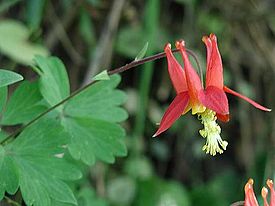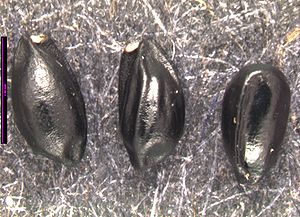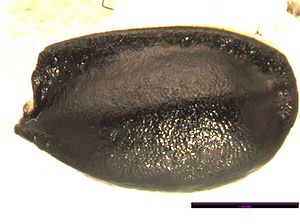Difference between revisions of "Aquilegia formosa"
(→Description) |
|||
| Line 1: | Line 1: | ||
| − | [[File:Aquilegia2.jpg| | + | [[File:Aquilegia2.jpg|right|275px|Aquilegia formosa]] |
| − | '''''Aquilegia formosa''''', also known as the red columbine, western columbine, or the Sitka columbine, is a flowering plant in the Ranunculaceae family. | + | '''''Aquilegia formosa''''', also known as the red columbine, western columbine, or the Sitka columbine, is a flowering plant in the Ranunculaceae family. <br><br> |
| + | '''Synonyms''' | ||
| + | ''Aquilegia canadensis L. var. formosa'' | ||
| + | ''Aquilegia columbiana Rydb.'' | ||
| + | ''Aquilegia formosa Fisch. ex DC. in part [H&C, KZ99]'' | ||
| + | ''Aquilegia formosa Fischer ex de Candolle var. communis B. Boivin'' | ||
| + | ''Aquilegia formosa Fischer ex de Candolle var. megalantha B. Boivin'' | ||
| + | ''Aquilegia formosa Fischer var. wawawensis (Payson) H. St. John'' <ref>[http://biology.burke.washington.edu/herbarium/waflora/checklist.php?Taxon=Aquilegia%20formosa%20var.%20formosa Washington Flora Checklist]</ref> | ||
| + | |||
| + | |||
===Taxonomy=== | ===Taxonomy=== | ||
*Kingdom Plantae – Plants | *Kingdom Plantae – Plants | ||
| Line 8: | Line 17: | ||
*Division Magnoliophyta – Flowering plants | *Division Magnoliophyta – Flowering plants | ||
*Class Magnoliopsida – Dicotyledons | *Class Magnoliopsida – Dicotyledons | ||
| − | *Subclass | + | *Subclass - Magnoliidae |
*Order Ranunculales | *Order Ranunculales | ||
*Family Ranunculaceae – Buttercup family | *Family Ranunculaceae – Buttercup family | ||
| Line 14: | Line 23: | ||
*Species Aquilegia formosa Fisch. ex DC. – western columbine | *Species Aquilegia formosa Fisch. ex DC. – western columbine | ||
===Description=== | ===Description=== | ||
| − | Densely pubescent perennial from a branched to simple woody base with several stems 1.5-10 dm. tall. Long petiolate, mostly basal leaves 1.5-5.5 cm long. Pale to deep red flowers usually several, nodding; sepals 5, petal-like, oblong-lanceolate, 1.5-2.5 cm. long; petals 5, yellow, with straight spurs 10-15 mm. long, the blades 2-5 mm. long; stamens numerous, the inner ones sterile and scale-like. Follicles 5, 2 cm. long, copiously glandular-puberulent. http://biology.burke.washington.edu/herbarium/imagecollection.php | + | Densely pubescent perennial from a branched to simple woody base with several stems 1.5-10 dm. tall. Long petiolate, mostly basal leaves 1.5-5.5 cm long. Pale to deep red flowers usually several, nodding; sepals 5, petal-like, oblong-lanceolate, 1.5-2.5 cm. long; petals 5, yellow, with straight spurs 10-15 mm. long, the blades 2-5 mm. long; stamens numerous, the inner ones sterile and scale-like. Follicles 5, 2 cm. long, copiously glandular-puberulent. <ref name="UW">[http://biology.burke.washington.edu/herbarium/imagecollection.php WTU Herbarium Profiles]</ref> |
===Bloom Period=== | ===Bloom Period=== | ||
| − | May-August | + | May-August <ref name="UW"/> |
===Distribution=== | ===Distribution=== | ||
| − | Widely distributed throughout Washington; Alaska south to California, coastal and inland to Alberta and Wyoming. | + | Widely distributed throughout Washington; Alaska south to California, coastal and inland to Alberta and Wyoming. <ref name="UW"/> |
===Habitat=== | ===Habitat=== | ||
| − | Open woods, lowlands to mid-elevations in the mountains. | + | Open woods, lowlands to mid-elevations in the mountains. <ref name="UW"/> |
===Uses=== | ===Uses=== | ||
===Propagation=== | ===Propagation=== | ||
| − | + | ||
| − | + | ||
===Seed=== | ===Seed=== | ||
| Line 54: | Line 62: | ||
{{Basics}} | {{Basics}} | ||
| + | ===Photo Gallery=== | ||
| + | <gallery> | ||
| + | File:Aquilegia2.jpg | ||
| + | File:Aquilegia formosa.jpg | ||
| + | File:Aquilegia formosa single.jpg | ||
| + | </gallery> | ||
| + | ===References=== | ||
| + | <References/> | ||
Revision as of 11:51, 23 April 2012
Aquilegia formosa, also known as the red columbine, western columbine, or the Sitka columbine, is a flowering plant in the Ranunculaceae family.
Synonyms
Aquilegia canadensis L. var. formosa
Aquilegia columbiana Rydb.
Aquilegia formosa Fisch. ex DC. in part [H&C, KZ99]
Aquilegia formosa Fischer ex de Candolle var. communis B. Boivin
Aquilegia formosa Fischer ex de Candolle var. megalantha B. Boivin
Aquilegia formosa Fischer var. wawawensis (Payson) H. St. John [1]
Contents
Taxonomy
- Kingdom Plantae – Plants
- Subkingdom Tracheobionta – Vascular plants
- Superdivision Spermatophyta – Seed plants
- Division Magnoliophyta – Flowering plants
- Class Magnoliopsida – Dicotyledons
- Subclass - Magnoliidae
- Order Ranunculales
- Family Ranunculaceae – Buttercup family
- Genus Aquilegia L. – columbine
- Species Aquilegia formosa Fisch. ex DC. – western columbine
Description
Densely pubescent perennial from a branched to simple woody base with several stems 1.5-10 dm. tall. Long petiolate, mostly basal leaves 1.5-5.5 cm long. Pale to deep red flowers usually several, nodding; sepals 5, petal-like, oblong-lanceolate, 1.5-2.5 cm. long; petals 5, yellow, with straight spurs 10-15 mm. long, the blades 2-5 mm. long; stamens numerous, the inner ones sterile and scale-like. Follicles 5, 2 cm. long, copiously glandular-puberulent. [2]
Bloom Period
May-August [2]
Distribution
Widely distributed throughout Washington; Alaska south to California, coastal and inland to Alberta and Wyoming. [2]
Habitat
Open woods, lowlands to mid-elevations in the mountains. [2]
Uses
Propagation
Seed
Abbreviation: AQFO
Seed sample from: 2011
Average Measurement: 2.5 x 1.4 x 1.2
Measurement Range: L: 2.5 - 2.75, W: 1.2 - 1.5, D: 1 - 1.5
Features
Shape: Seeds tapering at hilum end, broadening at opposite side.
Color: Hilum is white, seed is black.
Surface: At least one distinct ridge runs from the hilum to the opposite side. End opposite hilum is sometimes puckered or having concave pits. Seed is glossy and lightly textured with very small bumps.
Latitudinal Cross Section: elliptical ![]()
Longitudinal Cross Section: obovate ![]()
Basic Explanations and Assumptions:
The dimensions for the seeds are length x width x depth. The location of the hilum is used as the base of the seed, and the length is measured from hilum to the opposite apex. Where a style is present, the length is measured from the hilum to the bottom of the style. Width is measured at a right angle to the length at the widest part. Depth is measured at a right angle to the intersection of height and width lines.
Measurements included are the mean average for each measurement of ten separate seeds.
All measurements in millimeters unless otherwise noted.






